Yu Guan
PerfTracker: Online Performance Troubleshooting for Large-scale Model Training in Production
Jun 12, 2025



Abstract:Troubleshooting performance problems of large model training (LMT) is immensely challenging, due to unprecedented scales of modern GPU clusters, the complexity of software-hardware interactions, and the data intensity of the training process. Existing troubleshooting approaches designed for traditional distributed systems or datacenter networks fall short and can hardly apply to real-world training systems. In this paper, we present PerfTracker, the first online troubleshooting system utilizing fine-grained profiling, to diagnose performance issues of large-scale model training in production. PerfTracker can diagnose performance issues rooted in both hardware (e.g., GPUs and their interconnects) and software (e.g., Python functions and GPU operations). It scales to LMT on modern GPU clusters. PerfTracker effectively summarizes runtime behavior patterns of fine-grained LMT functions via online profiling, and leverages differential observability to localize the root cause with minimal production impact. PerfTracker has been deployed as a production service for large-scale GPU clusters of O(10, 000) GPUs (product homepage https://help.aliyun.com/zh/pai/user-guide/perftracker-online-performance-analysis-diagnostic-tool). It has been used to diagnose a variety of difficult performance issues.
REMEDI: Relative Feature Enhanced Meta-Learning with Distillation for Imbalanced Prediction
May 12, 2025Abstract:Predicting future vehicle purchases among existing owners presents a critical challenge due to extreme class imbalance (<0.5% positive rate) and complex behavioral patterns. We propose REMEDI (Relative feature Enhanced Meta-learning with Distillation for Imbalanced prediction), a novel multi-stage framework addressing these challenges. REMEDI first trains diverse base models to capture complementary aspects of user behavior. Second, inspired by comparative op-timization techniques, we introduce relative performance meta-features (deviation from ensemble mean, rank among peers) for effective model fusion through a hybrid-expert architecture. Third, we distill the ensemble's knowledge into a single efficient model via supervised fine-tuning with MSE loss, enabling practical deployment. Evaluated on approximately 800,000 vehicle owners, REMEDI significantly outperforms baseline approaches, achieving the business target of identifying ~50% of actual buyers within the top 60,000 recommendations at ~10% precision. The distilled model preserves the ensemble's predictive power while maintaining deployment efficiency, demonstrating REMEDI's effectiveness for imbalanced prediction in industry settings.
TrainMover: Efficient ML Training Live Migration with No Memory Overhead
Dec 17, 2024



Abstract:Machine learning training has emerged as one of the most prominent workloads in modern data centers. These training jobs are large-scale, long-lasting, and tightly coupled, and are often disrupted by various events in the cluster such as failures, maintenance, and job scheduling. To handle these events, we rely on cold migration, where we first checkpoint the entire cluster, replace the related machines, and then restart the training. This approach leads to disruptions to the training jobs, resulting in significant downtime. In this paper, we present TrainMover, a live migration system that enables machine replacement during machine learning training. TrainMover minimizes downtime by leveraging member replacement of collective communication groups and sandbox lazy initialization. Our evaluation demonstrates that TrainMover achieves 16x less downtime compared to all baselines, effectively handling data center events like straggler rebalancing, maintenance, and unexpected failures.
DynFocus: Dynamic Cooperative Network Empowers LLMs with Video Understanding
Nov 19, 2024Abstract:The challenge in LLM-based video understanding lies in preserving visual and semantic information in long videos while maintaining a memory-affordable token count. However, redundancy and correspondence in videos have hindered the performance potential of existing methods. Through statistical learning on current datasets, we observe that redundancy occurs in both repeated and answer-irrelevant frames, and the corresponding frames vary with different questions. This suggests the possibility of adopting dynamic encoding to balance detailed video information preservation with token budget reduction. To this end, we propose a dynamic cooperative network, DynFocus, for memory-efficient video encoding in this paper. Specifically, i) a Dynamic Event Prototype Estimation (DPE) module to dynamically select meaningful frames for question answering; (ii) a Compact Cooperative Encoding (CCE) module that encodes meaningful frames with detailed visual appearance and the remaining frames with sketchy perception separately. We evaluate our method on five publicly available benchmarks, and experimental results consistently demonstrate that our method achieves competitive performance.
Sub-DM:Subspace Diffusion Model with Orthogonal Decomposition for MRI Reconstruction
Nov 06, 2024



Abstract:Diffusion model-based approaches recently achieved re-markable success in MRI reconstruction, but integration into clinical routine remains challenging due to its time-consuming convergence. This phenomenon is partic-ularly notable when directly apply conventional diffusion process to k-space data without considering the inherent properties of k-space sampling, limiting k-space learning efficiency and image reconstruction quality. To tackle these challenges, we introduce subspace diffusion model with orthogonal decomposition, a method (referred to as Sub-DM) that restrict the diffusion process via projections onto subspace as the k-space data distribution evolves toward noise. Particularly, the subspace diffusion model circumvents the inference challenges posed by the com-plex and high-dimensional characteristics of k-space data, so the highly compact subspace ensures that diffusion process requires only a few simple iterations to produce accurate prior information. Furthermore, the orthogonal decomposition strategy based on wavelet transform hin-ders the information loss during the migration of the vanilla diffusion process to the subspace. Considering the strate-gy is approximately reversible, such that the entire pro-cess can be reversed. As a result, it allows the diffusion processes in different spaces to refine models through a mutual feedback mechanism, enabling the learning of ac-curate prior even when dealing with complex k-space data. Comprehensive experiments on different datasets clearly demonstrate that the superiority of Sub-DM against state of-the-art methods in terms of reconstruction speed and quality.
Zero-shot Dynamic MRI Reconstruction with Global-to-local Diffusion Model
Nov 06, 2024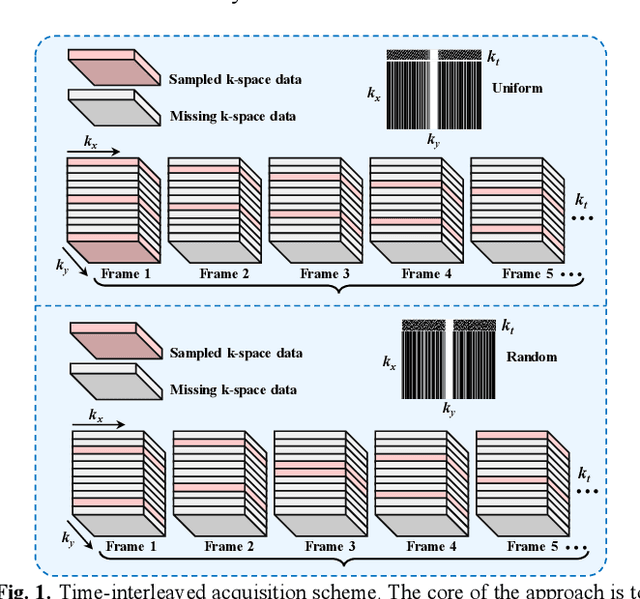
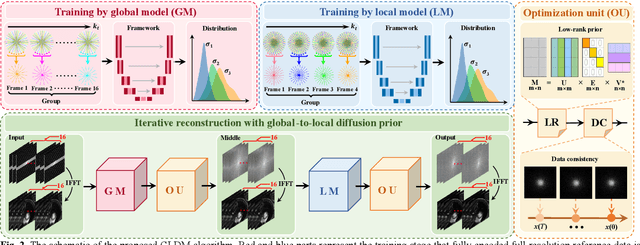
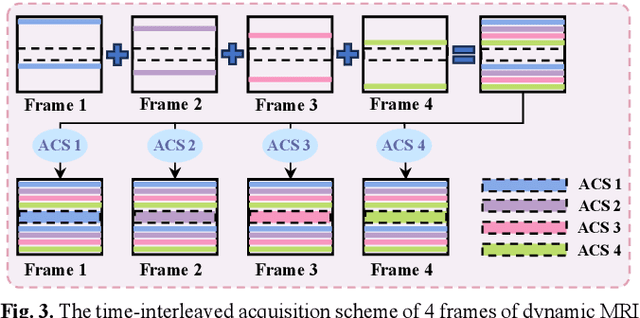
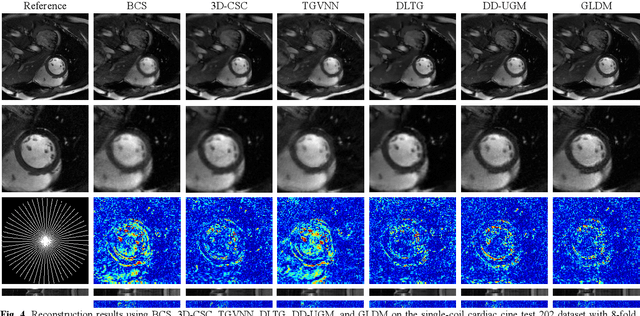
Abstract:Diffusion models have recently demonstrated considerable advancement in the generation and reconstruction of magnetic resonance imaging (MRI) data. These models exhibit great potential in handling unsampled data and reducing noise, highlighting their promise as generative models. However, their application in dynamic MRI remains relatively underexplored. This is primarily due to the substantial amount of fully-sampled data typically required for training, which is difficult to obtain in dynamic MRI due to its spatio-temporal complexity and high acquisition costs. To address this challenge, we propose a dynamic MRI reconstruction method based on a time-interleaved acquisition scheme, termed the Glob-al-to-local Diffusion Model. Specifically, fully encoded full-resolution reference data are constructed by merging under-sampled k-space data from adjacent time frames, generating two distinct bulk training datasets for global and local models. The global-to-local diffusion framework alternately optimizes global information and local image details, enabling zero-shot reconstruction. Extensive experiments demonstrate that the proposed method performs well in terms of noise reduction and detail preservation, achieving reconstruction quality comparable to that of supervised approaches.
USTC-KXDIGIT System Description for ASVspoof5 Challenge
Sep 03, 2024
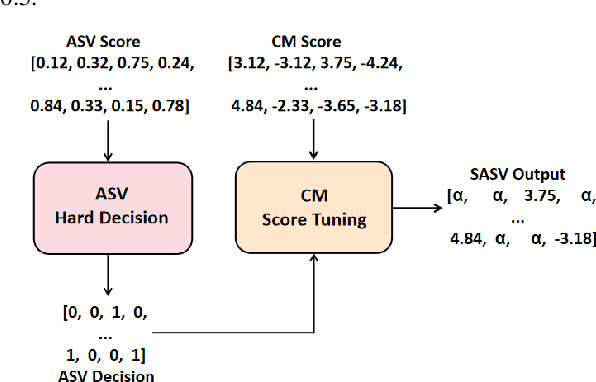
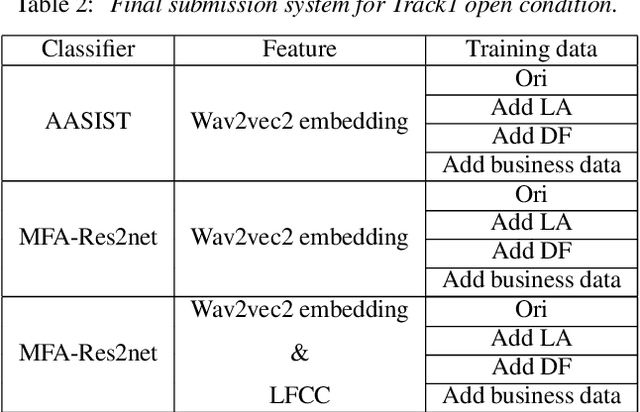
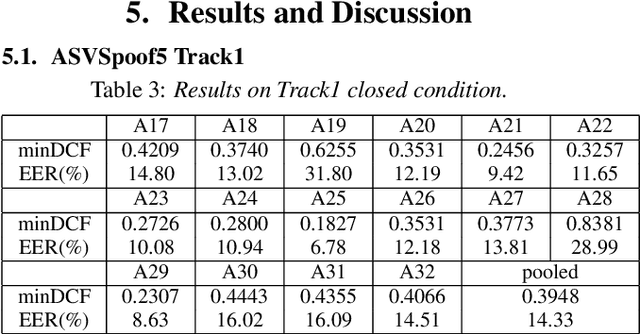
Abstract:This paper describes the USTC-KXDIGIT system submitted to the ASVspoof5 Challenge for Track 1 (speech deepfake detection) and Track 2 (spoofing-robust automatic speaker verification, SASV). Track 1 showcases a diverse range of technical qualities from potential processing algorithms and includes both open and closed conditions. For these conditions, our system consists of a cascade of a frontend feature extractor and a back-end classifier. We focus on extensive embedding engineering and enhancing the generalization of the back-end classifier model. Specifically, the embedding engineering is based on hand-crafted features and speech representations from a self-supervised model, used for closed and open conditions, respectively. To detect spoof attacks under various adversarial conditions, we trained multiple systems on an augmented training set. Additionally, we used voice conversion technology to synthesize fake audio from genuine audio in the training set to enrich the synthesis algorithms. To leverage the complementary information learned by different model architectures, we employed activation ensemble and fused scores from different systems to obtain the final decision score for spoof detection. During the evaluation phase, the proposed methods achieved 0.3948 minDCF and 14.33% EER in the close condition, and 0.0750 minDCF and 2.59% EER in the open condition, demonstrating the robustness of our submitted systems under adversarial conditions. In Track 2, we continued using the CM system from Track 1 and fused it with a CNN-based ASV system. This approach achieved 0.2814 min-aDCF in the closed condition and 0.0756 min-aDCF in the open condition, showcasing superior performance in the SASV system.
Boosting Large-scale Parallel Training Efficiency with C4: A Communication-Driven Approach
Jun 07, 2024

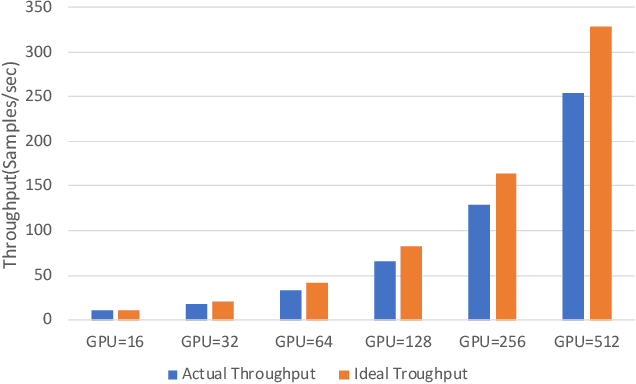

Abstract:The emergence of Large Language Models (LLMs) has necessitated the adoption of parallel training techniques, involving the deployment of thousands of GPUs to train a single model. Unfortunately, we have found that the efficiency of current parallel training is often suboptimal, largely due to the following two main issues. Firstly, hardware failures are inevitable, leading to interruptions in the training tasks. The inability to quickly identify the faulty components results in a substantial waste of GPU resources. Secondly, since GPUs must wait for parameter synchronization to complete before proceeding to the next round of computation, network congestions can greatly increase the waiting time for GPUs. To address these challenges, this paper introduces a communication-driven solution, namely the C4. The key insights of C4 are two folds. First, in parallel training, collective communication exhibits periodic and homogeneous characteristics, so any anomalies are certainly due to some form of hardware malfunction. By leveraging this feature, C4 can rapidly identify the faulty components, swiftly isolate the anomaly, and restart the task, thereby avoiding resource wastage caused by delays in anomaly detection. Second, the predictable communication model of collective communication, involving few large flows, allows C4 to efficiently execute traffic planning, substantially reducing network congestion. C4 has been extensively implemented across our production systems, cutting error-induced overhead by roughly 30% and enhancing runtime performance by about 15% for certain applications with moderate communication costs.
Synthetic CT Generation via Variant Invertible Network for All-digital Brain PET Attenuation Correction
Oct 03, 2023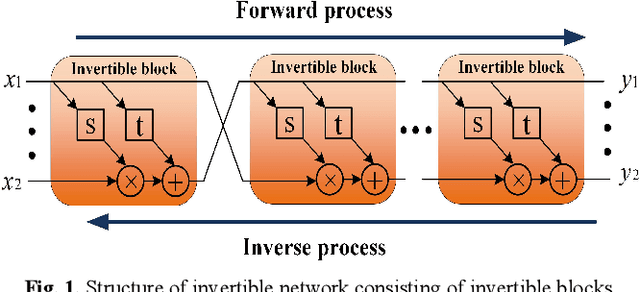
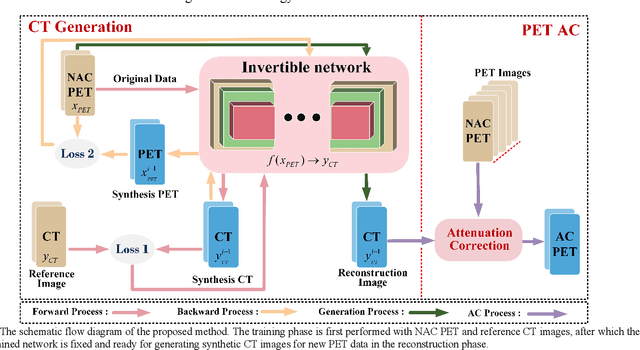
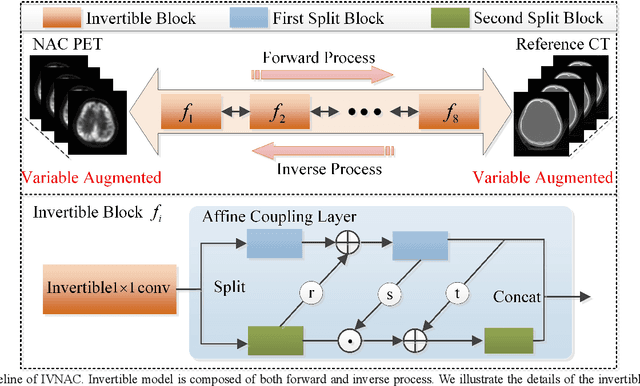
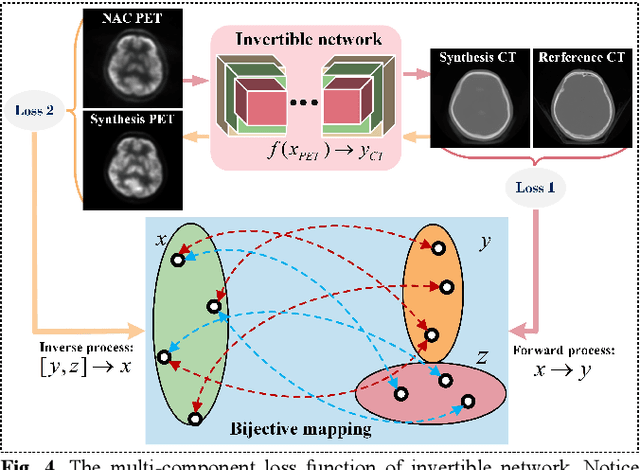
Abstract:Attenuation correction (AC) is essential for the generation of artifact-free and quantitatively accurate positron emission tomography (PET) images. However, AC of PET faces challenges including inter-scan motion and erroneous transformation of structural voxel-intensities to PET attenuation-correction factors. Nowadays, the problem of AC for quantitative PET have been solved to a large extent after the commercial availability of devices combining PET with computed tomography (CT). Meanwhile, considering the feasibility of a deep learning approach for PET AC without anatomical imaging, this paper develops a PET AC method, which uses deep learning to generate continuously valued CT images from non-attenuation corrected PET images for AC on brain PET imaging. Specifically, an invertible network combined with the variable augmentation strategy that can achieve the bidirectional inference processes is proposed for synthetic CT generation (IVNAC). To evaluate the performance of the proposed algorithm, we conducted a comprehensive study on a total of 1440 data from 37 clinical patients using comparative algorithms (such as Cycle-GAN and Pix2pix). Perceptual analysis and quantitative evaluations illustrate that the invertible network for PET AC outperforms other existing AC models, which demonstrates the potential of the proposed method and the feasibility of achieving brain PET AC without CT.
Correlated and Multi-frequency Diffusion Modeling for Highly Under-sampled MRI Reconstruction
Sep 02, 2023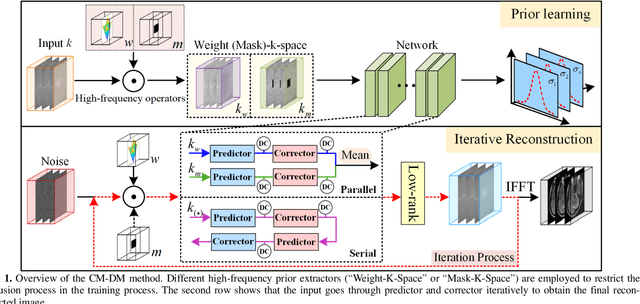
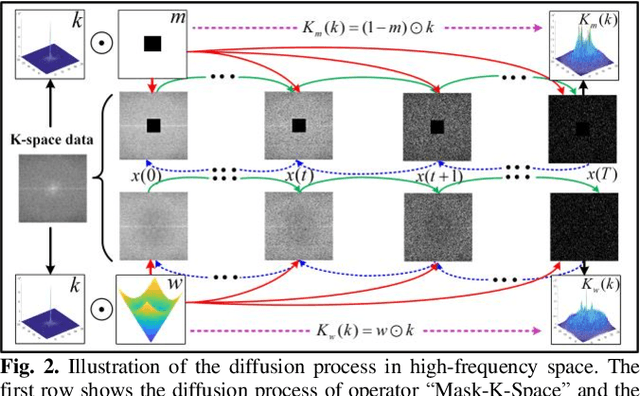
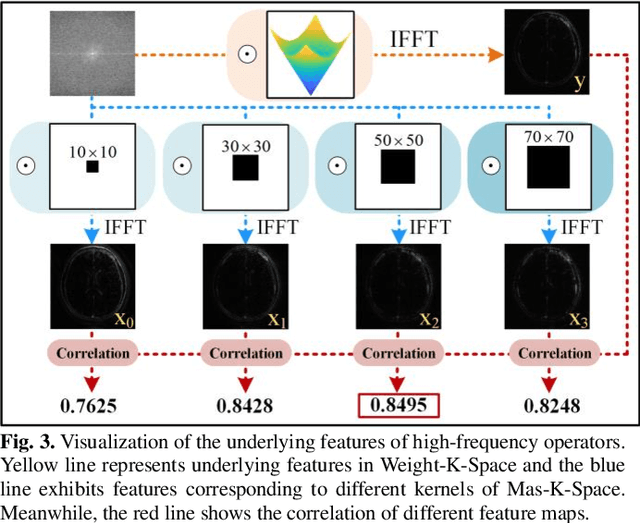
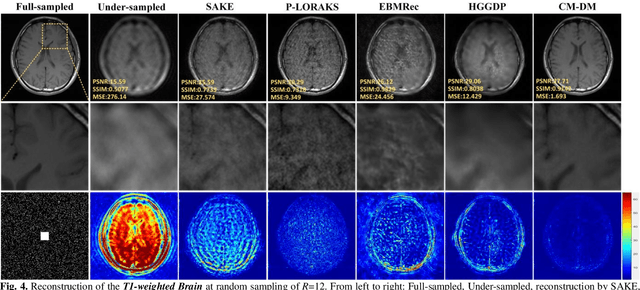
Abstract:Most existing MRI reconstruction methods perform tar-geted reconstruction of the entire MR image without tak-ing specific tissue regions into consideration. This may fail to emphasize the reconstruction accuracy on im-portant tissues for diagnosis. In this study, leveraging a combination of the properties of k-space data and the diffusion process, our novel scheme focuses on mining the multi-frequency prior with different strategies to pre-serve fine texture details in the reconstructed image. In addition, a diffusion process can converge more quickly if its target distribution closely resembles the noise distri-bution in the process. This can be accomplished through various high-frequency prior extractors. The finding further solidifies the effectiveness of the score-based gen-erative model. On top of all the advantages, our method improves the accuracy of MRI reconstruction and accel-erates sampling process. Experimental results verify that the proposed method successfully obtains more accurate reconstruction and outperforms state-of-the-art methods.
 Add to Chrome
Add to Chrome Add to Firefox
Add to Firefox Add to Edge
Add to Edge